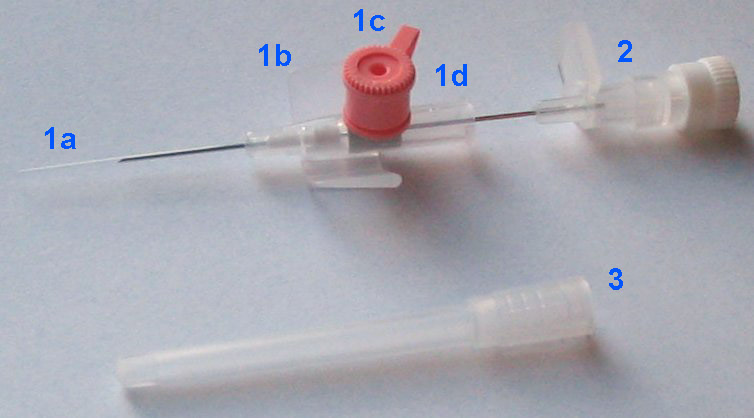- Peripheral venous catheter
thumb|right|Standard catheter. 1. The catheter itself is composed of (a) a tip for insertion into the vein, (b) wings for manual handling and securing the catheter with adhesives, (c) a valve to allow injection of drugs with a syringe, (d) an end which allows connection to an intravenous infusion line, and capping in between uses. 2. The needle (partially retracted) which serves only as a guidewire for inserting the cannula. 3. The protection cap which normally covers the needle's tip.In
medicine , a peripheral venous catheter (PVC or "peripheral venous line" or "peripheral venous access catheter") is acatheter (small, flexible tube) placed into aperipheral vein in order to administer medication or fluids. Once placed, the line can also be used to draw blood.The catheter is introduced into the vein by a needle (similar to blood drawing), which is subsequently removed while the small tube of the cannula remains in place. The catheter is then fixed by taping it to the patient's skin (unless there is allergy to adhesives). Newer catheters have been equipped with additional safety features to avoid needlestick injuries. Modern catheters consist of synthetic polymers such as
teflon (hence the often used term 'Venflon' for these venous catheters).A peripheral venous catheter is the most commonly used vascular access in medicine. It is given to most
emergency room and surgical patients, and before some radiological imaging techniques usingradiocontrast , for example. In the United States, more than 25 million patients get a peripheral venous line each year.cite journal |author=Soifer NE, Borzak S, Edlin BR, Weinstein RA |title=Prevention of peripheral venous catheter complications with an intravenous therapy team: a randomized controlled trial |journal=Arch. Intern. Med. |volume=158 |issue=5 |pages=473–7 |year=1998 |month=March |pmid=9508225 |doi= |url=http://archinte.ama-assn.org/cgi/pmidlookup?view=long&pmid=9508225]A peripheral venous catheter is usually placed in a vein on the hand or arm. It should be distinguished from a
central venous catheter which is inserted in a central vein (usually in theinternal jugular vein of the neck or thesubclavian vein of the chest), or anarterial catheter which can be placed in a peripheral as well as a central artery. In children, local analgesic (painkiller) gel (such aslidocaine ) is applied to the insertion site to facilitate placement.Complications
Infection,
phlebitis , extravasation, infiltration,air embolism ,hemorrhage (bleeding) and formation of a hematoma (bruise) may occur.Because of the risk of insertion-site infection the
CDC advises in their guideline that the catheter needs to be replaced every 96 hours. [cite web
last = CDC Morbidity and Mortality Weekly Report Aug 2002
title = Guidelines for the Prevention of Intravascular Catheter-Related Infections
url=http://www.cdc.gov/mmwr/preview/mmwrhtml/rr5110a1.htm | accessdate = 2008-03-13 ] Although these catheters can best not be left in place longer than necessary, the need to replace these catheters routinely is debated.cite journal |author=Bregenzer T, Conen D, Sakmann P, Widmer AF |title=Is routine replacement of peripheral intravenous catheters necessary? |journal=Arch. Intern. Med. |volume=158 |issue=2 |pages=151–6 |year=1998 |month=January |pmid=9448553 |doi= |url=http://archinte.ama-assn.org/cgi/pmidlookup?view=long&pmid=9448553] Expert management has been shown to reduce the complications of peripheral lines.cite journal |author=Soifer NE, Borzak S, Edlin BR, Weinstein RA |title=Prevention of peripheral venous catheter complications with an intravenous therapy team: a randomized controlled trial |journal=Arch. Intern. Med. |volume=158 |issue=5 |pages=473–7 |year=1998 |month=March |pmid=9508225 |doi= |url=http://archinte.ama-assn.org/cgi/pmidlookup?view=long&pmid=9508225] cite journal |author=Miller JM, Goetz AM, Squier C, Muder RR |title=Reduction in nosocomial intravenous device-related bacteremias after institution of an intravenous therapy team |journal=J Intraven Nurs |volume=19 |issue=2 |pages=103–6 |year=1996 |pmid=8852171 |doi= |url=]
=AdditionalReferences
External links
* [http://www.cancer.gov/templates/db_alpha.aspx?CdrID=463728 National Cancer Institute: peripheral venous catheter]
* [http://www.health.qld.gov.au/chrisp/icare/pivc_rec_prac.pdf Recommended practices for the insertion and management of peripheral intravenous cathers (PIVC)]
Wikimedia Foundation. 2010.

